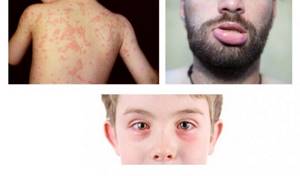Dog allergies - causes
Can you be allergic to dog hair?
Dog allergies occur due to increased sensitivity of the immune system to certain, usually harmless proteins that are found in the animal's saliva, urine, epithelium and sebaceous glands.
Many people mistakenly believe that they are allergic to dog hair, but contrary to popular belief, it is not the dog's hair itself that causes allergies, but the proteins that are found on it.
The main antigen that causes allergies is Can f 1. When it comes into contact with the mucous membranes and bronchi of a person, it can provoke the development of an allergic reaction.
Dogs and cats produce different proteins, but some of them are similar in structure, which is why some people who are allergic to dogs have a reaction to cats. This phenomenon is called cross allergy.
How does a dog allergy manifest?
Symptoms manifest differently for everyone: an allergy can develop immediately upon contact with an animal (immediate type of allergic reaction) or several days later (delayed type).
Allergens can be in the air or on the clothes of pet owners, so an allergic reaction can occur even with indirect contact with an allergen, for example, at a party or in public places: kindergartens, schools, offices, public transport, etc.
Allergy symptoms depend on how the interaction with the allergen occurred. If it gets on the mucous membrane of the eyes, redness, burning and itching in the eyes occurs - allergic conjunctivitis develops.

Allergy to dog (photo)
Inhalation or settling of the allergen on the nasal mucosa can cause irritation of the respiratory tract, causing symptoms reminiscent of hay fever: watery nasal discharge, frequent sneezing, swelling of the pharyngeal mucosa, leading to coughing, difficulty swallowing and sore throat.
Skin manifestations of allergies are expressed in the form of redness and swelling of the skin, urticaria or itchy blisters on the face, neck, chest or arms, Quincke's edema.
In rare cases, dog allergens can trigger asthma attacks, which can cause difficulty breathing and shortness of breath.
In severe cases, anaphylactic shock is possible, which threatens a person’s life, during which a sharp drop in blood pressure and loss of consciousness occurs.
Allergies in dogs: symptoms
In order to diagnose a food allergy, a special diagnosis is carried out, which is called an elimination diet. At first, foods that are part of the dog’s usual diet are removed from the dog’s diet, and then they are gradually returned. After this, the dog’s owner looks at which product was administered when the relapse occurred. Most often, this diet is introduced with full confidence that the dog does not have fleas, scabies mites, and other pathogens that provoke severe itching and hair loss in certain places.
Allergies in dogs, symptoms:
- Allergies in four-legged friends manifest themselves in the same way as in people. Usually this is redness of the eyes, discharge of a large amount of mucus from the nose and mouth, rashes, redness, and severe itching.
- In general, the dog may feel quite unwell and may feel unwell. However, the temperature remains normal.
- Typically, allergy rashes appear on the face, ears, and in the folds of the skin, under the paws. Often redness and pimples appear in these areas, which the dog may scratch.
READ ALSO: Wen on the stomach under the skin: symptoms, causes, how to get rid
Cute dogs
Allergy to dogs in children

Allergies to dogs in newborns may occur due to a hereditary tendency. If one or both parents had allergic diseases, the probability that the child will be allergic to a dog is 50%.
Carrying out preventive measures can reduce the risk of allergies in newborns.
The symptoms that occur in a baby are varied: itchy rashes all over the body, watery eyes, runny nose, sneezing, wheezing while breathing, eczema - a painful inflammation of the skin.

Allergy to a dog in an infant (photo)
In rare cases, a baby may experience Quincke's edema or anaphylactic shock, which is life-threatening. In this case, emergency medical attention is required.
If a child suffered from a dog allergy as a child, this does not mean that he will continue to react to it in adulthood. The children's immune system is very vulnerable, so once its formation is completed, the child manages to get rid of it.
How to get rid of dog allergies?
If you have an allergy to pets, you should consult a doctor - an allergist, who will take an anamnesis and, based on it, prescribe laboratory tests and skin testing, and also determine the appropriate treatment.
Skin testing is carried out by applying allergens to the skin of the hand, which is then pricked with a special lancet. If the skin turns red at the puncture site and an itchy blister forms, the reaction to the allergen is positive.
Prick test
This method allows you to assess the body's reaction to suspected allergens within 20 minutes. Contraindications for this procedure include age under 5 years.
A laboratory allergy test is also carried out: the blood is tested for the presence of antibodies (immunoglobulin E), an elevated level of which indicates the presence of an allergy. This method can be used to diagnose allergies, both in an adult with increased sensitivity of the immune system, and in a small child, as it completely eliminates the occurrence of complications in the form of allergic reactions.
Where to get tested? You can get tested for allergies to dogs either in clinics with a referral from an allergist, or on your own in medical centers.
Diagnosis of the disease
Traces of manifestations of the irritant are more often observed in those places where a person had direct contact with the pathogenic protein. Apart from the respiratory organs, the hands suffer the most. But a rash that appears on the palms is not necessarily a sign of an allergy. There are a large number of other causes that also have this symptom. To find out if you have an allergy, it is recommended to consult a doctor.
An allergist can help solve the problem.
After a visual examination and communication with the patient, the doctor makes a presumptive diagnosis. To obtain accurate results, a number of studies will be required. In a standard situation, when all factors indicate that a dog is allergic, it is enough to donate blood and skin tests. This test provides an opportunity to check if a pet allergy or unpleasant symptoms are caused by another irritant. When the result is negative, that is, the problem is not in the pet, the patient will undergo a more detailed diagnosis, which will help identify the source of the pathological process.
It should be borne in mind that there are a lot of foreign agents that cause an appropriate reaction of the immune system. In some cases, the root cause of the problem cannot be found.
It is possible to try to find out on your own whether the dog is the cause of the ailments. Before determining whether a pet is causing an allergy, you must stop contacting it. In addition, all traces of his presence (toys, food tray, etc.) should be removed.
If after such actions the symptoms begin to gradually disappear, then the dog caused the allergy.
Sometimes a pet can cause the irritant to spread. For example, if the provocateur of unpleasant symptoms is plant pollen, then the animal can carry it into the house on its fur.
How to cure dog allergies?
Allergy to dog epithelium (and other allergens) is currently treated with the only effective method - allergen-specific immunotherapy (ASIT).
The essence of the therapy is the injection of allergens under a person’s skin or under the tongue (sublingual). Treatment begins with a small dose, which is gradually increased to the maximum value determined by the allergist. The course can take a long time – up to 3 years.

Sublingual ASIT
Drug treatment is used to relieve symptoms but not cure the disease. To eliminate the main manifestations of allergies, such as runny nose, lacrimation and skin rashes caused by the action of histamine, antihistamines are used in the form of tablets and drops, for example Zodak, Cetrin, Naphthyzin, etc.
You can get rid of allergic skin itching by topical application of an antihistamine or corticosteroid (hormonal) ointment to the skin: Fenistil, Hydrocortisone, etc.
Preventive actions

Allergy to a dog - what to do?
If you keep your pet in an apartment or house, you should minimize contact with allergens in the following ways:
- Carry out wet cleaning at least once a week.
- Get rid of (or vacuum daily) carpets and other dust collectors, as settled allergens are found in high concentrations on them.
- Use an air purifier and vacuum cleaner with a HEPA filter.
- Wash and brush your dog weekly.
- Keep the room locked: Do not allow your dog to enter the bedroom (or nursery) or sleep on the bed.
- Always wash your hands with soap after handling an animal.
- If you are allergic to a dog's saliva, do not let it lick you.
- If the dog lives inside the house, try to move it to a kennel outside.
Symptoms of the disease
Based on how allergies to dogs manifest themselves in adults, we can make an assumption about whether a child also has this disease.

Symptoms do not always appear immediately after contact with the animal. Sometimes the first signs of an allergy to dogs appear a few months after a four-legged friend appears in the family.
The characteristic symptoms of the disease are as follows:
- rhinitis;
- tearfulness;
- swelling of the nasal mucosa;
- itching and hyperemia of the skin;
- dermatitis;
- minor skin rash;
- tissue swelling;
- disruption of the respiratory system;
- digestive tract disorder;
- dizziness;
- weakness;
- otitis media and hearing loss.
What dog breeds do not cause allergies?
Allergy-free dogs are an allergy sufferer's dream. However, unfortunately, there are no hypoallergenic dog breeds. But there is an opinion that short-haired dogs cause allergic reactions more often than long-haired dogs. This is due to the fact that smooth-haired dogs shed almost all year round, and therefore pose the greatest danger. However, if a person is allergic to animal saliva, any breed of dog is not suitable for him to keep.
Which dogs are not allergic?

Symptoms
Depending on the disease that caused the itching, different accompanying symptoms will be observed. If your dog scratches his ears and whines, this is a clear sign that he is in pain. This can even lead to attacks of aggression, especially when a person touches a sore spot. Pain in the ears and jaws when chewing often accompanies otitis media. The animal also tilts its head to the side, thereby reducing the pressure inside the ear.
Infectious otitis media occurs with fever, weakness, and loss of appetite. The auricle turns red and becomes hot, a putrid odor emanates from it, and the ear canal becomes covered with purulent crusts. If your pet has otitis media or internal otitis media, his hearing will begin to deteriorate, which may result in complete hearing loss. An allergic reaction is indicated by constant scratching of the ears and eyelids after contact with an allergen. With allergic eczema, small bubbles with liquid contents form in the ears.
READ ALSO: What is the danger of the appearance of wen on the face, head, nose of a baby
If a dog scratches its ears until it bleeds, shakes its head and bends it towards the ground, this indicates unbearable itching, caused by a tick. With this disease, a dark liquid is released from the ears, which quickly dries out and forms crusts, and on the outer side of the auricle the fur thins and wounds from scratching appear.





![[Photo review] “A Sassy Nation” bodysuit from Black Milk Clothing](https://superlady555.ru/wp-content/uploads/fotoobzor-bodi-a-sassy-nation-ot-black-milk-clothing-330x140.jpg)





